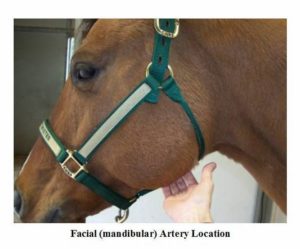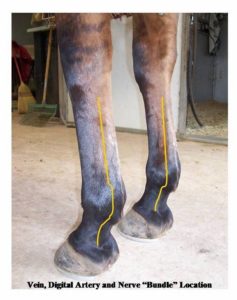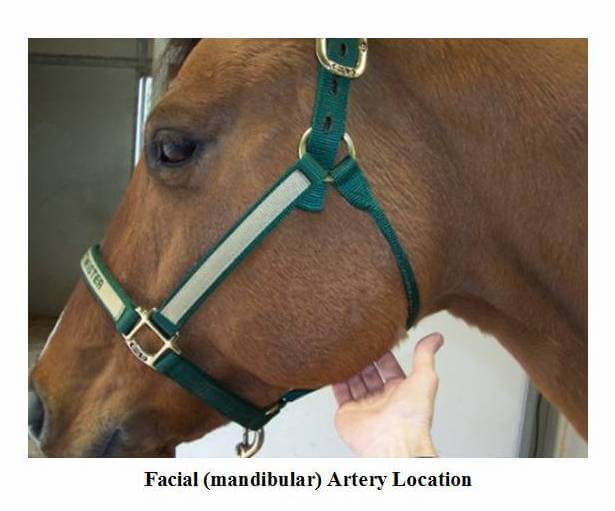by Eleanor Blazer
Do you know the average resting pulse rate of your horse? You may know that the normal resting pulse rate of an adult horse is between 25 and 50 beats per minute (bpm), but what is your horse’s rate? Because of the wide margin of normalcy, the resting pulse rate for individual horses should be known and recorded.
The pulse is one of three vital signs taken to check a horse’s health. The other two are the temperature and respiration rate. An abnormal resting pulse rate can signify infection, dehydration, stress, pain and an erratic heartbeat.
The pulse must be taken when the horse is calm and resting. Do not try to get an accurate reading when there is a lot of activity in the barn, just before feeding time or after exercise. Don’t make a big production of it, either. Stay calm and keep the horse quiet.
The pulse should be taken at the same time every day for five days. Make a note of each reading and average them. To get an average, add the results of the five days and divide the answer by five: the answer is the average normal pulse for that horse. The easiest way to check a horse’s heart rate is to use a stethoscope and listen to the heart. Place the stethoscope on the girth area just behind the left elbow. The heart makes two sounds—“lub” then “dub”—which counts as a single beat. Count the number of beats that occur in 15 seconds, multiply that by four and you’ll have your horse’s resting heart rate per minute. Since most watches no longer have second hands, I use the timer on my phone.

You should also know how to manually take the pulse. In order to do this you have to find where an artery is close to the surface. There are several locations, but the easiest to find is under the jaw. Stand on the left side of a haltered horse, hold the lead shank with your left hand and use your right hand to locate the pulse. You are trying to find the facial (mandibular) artery. Use the fingers of your right hand and feel along the inside of the lower jaw. The artery will be in the vicinity of the last cheek tooth, inside the jawbone. When you reach the right location you’ll feel a cord-like shape. Press that structure lightly against the jawbone; you should detect the pulse. You need to exert gentle pressure, just touching the skin will not be enough. Count the number of beats that occur in 15 seconds and multiply by four.

There is a second location for taking a horse’s pulse, the digital pulse. An easily detected digital pulse can be a sign of inflammation in the hoof. Inflammation is a symptom of laminitis, an internal abscess, a bruise or other trauma to the hoof, but be aware that a horse could be suffering from one of these illnesses and still have a normal digital pulse rate. Make note of other symptoms such as heat, lameness, temperature, depression, accelerated heart rate and overall attitude. There are two digital arteries. Just above the fetlock they branch off from the medial palmar artery and continue down to the hoof, one on each side. The one to the inside of the horse is called the medial palmar artery; the one to the outside is the lateral palmar artery. Above and below the fetlock they are close to the surface and can be monitored for pulse.
Published February 2014 Issue

Eleanor Blazer was raised training and caring for horses. She learned to ride and care for the horses her family bought and sold. Many of these horses required improved nutrition when they arrived for training. Eleanor’s experience and research has benefited both horses and horse lovers in the field of equine nutrition. An equine nutrition consultant, based in Bulverde, Texas, she keeps busy doing equine nutrition consultations, conducting seminars, and speaking to youth groups about horse care and nutrition. Eleanor is the author of the syndicated column The Way of Horses. She has more than 20 years experience helping and being a mentor to those wanting to know how to provide the very best care and nutrition for our special friend – the horse.





